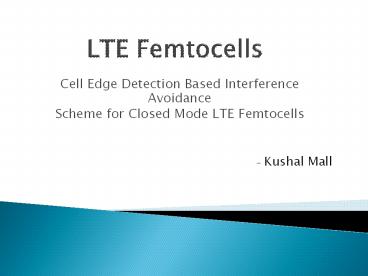LTE Femtocells
1 / 17
Title: LTE Femtocells
1
LTE Femtocells
- Cell Edge Detection Based Interference Avoidance
- Scheme for Closed Mode LTE Femtocells
- Kushal Mall
2
Agenda
- Femtocells
- Problem Statement
- Cross-Tier Interference
- Closed-Mode Femtocell
- Proposed Solution
- Simulation Results
- Advantages of the Proposed Scheme
- Conclusion
- Reference
3
Femtocells
- Femtocells are low power devices optimized for
used in home and small businesses - They connect via broadband infrastructure to
provide enhanced network connectivity within the
home and better QoS of the users - Femtocells position and placement is independent
of the operators planning - The range for a femtocell is 30-40 m
4
Problem Statement
- Cross-tier interference caused by nonsubscribed
users at the edge cell in the closed mode
Femtocell
5
Cross-Tier Interference
- Occurs when a non-subscribed user operating at
the same Resource Block(RB), but with a higher
transmitting power comes in the vicinity of a
femtocell - The uplink cross-tier interference felt at closed
mode femtocell is considered as the most common
case
6
Cross-Tier Interference Effects
- High deterioration of the femtocell capacity
- QoS of users and
- Decrease in cell throughput
7
Closed Mode Femtocell
- The femtocells maintain a list of subscribed
users which they use to authenticate the users.
Any unsubscribed user cannot hand in to the
closed mode femtocell. - Does not alleviate the network load but can
assure a dedicated bandwidth to the subscribed
users. Hence, billing is much easier in this mode
of femtocell
8
Proposed Solution
- Is an effective threshold based interference
avoidance scheme working on the principles of
Universal Frequency Reuse to obtain higher cell
throughput - It is based on SINR thresholding and 9 dB has
been considered the threshold - Whenever the threshold is breached by Macro cell
User Equipment (MUE), the interference avoidance
mechanism begins
9
- The orthogonal Resource Blocks (RBs) are
allocated to the MUE based on the decision
(Current Interference gt Initial Interference) - Interference is avoided by orthogonal RB
allocation to the MUEs - Thus, all the RBs are utilized per TTI resulting
in better overall cell throughput - Co-tier interference among femtocells has been
considered negligible in the proposed solution
10
Flowchart of the Proposed Scheme
11
Simulation Results
- The proposed scheme has been compared with the
FFR scheme - For simplicity, a two cell scenario has been
considered - One closed mode femtocell has been placed at the
cell edge (distance from the center greater than
650 m) of one of the macro cells - The femtocell has one subscribed user connected
to it.
12
Femto User SINR Comparison
- The average SINR level for the mentioned schemes
remains in the range - (16.5-17.5dB). Increasing the MUE speed from
3km/hr (pedestrian) - to 30km/hr (vehicular) shows little effect on the
femto user - SINR
13
Throughput Comparison (Urban)
- It can be seen that at MUE speed of 3km/hr, on
average the UFR based - scheme results in 22, 14 and 3 increase in
the throughput than FFR, - EFFR and PC respectively. At MUE speed of
30km/hr, the UFR results in - 18, 13 and 2 better results than FFR, EFFR and
PC respectively
14
Advantages of the Proposed Scheme
- Low complexity
- Scalability
- Minimum backhaul signaling required ( since
femtocell location and power information is not
required)
15
Conclusion
- The proposed scheme results shows improvement in
terms of - macro cell throughput
- spectral efficiency
- SINR of the femtocell user
- However, a little tradeoff was observed in terms
of slight increase in packet delay as compared to
the FRR scheme
16
Reference
- Cell Edge Detection Based Interference Avoidance
Scheme for Closed Mode LTE Femtocells by Syed
Muhammad Ali and Adnan Khalid Kiani
17
Thank You































